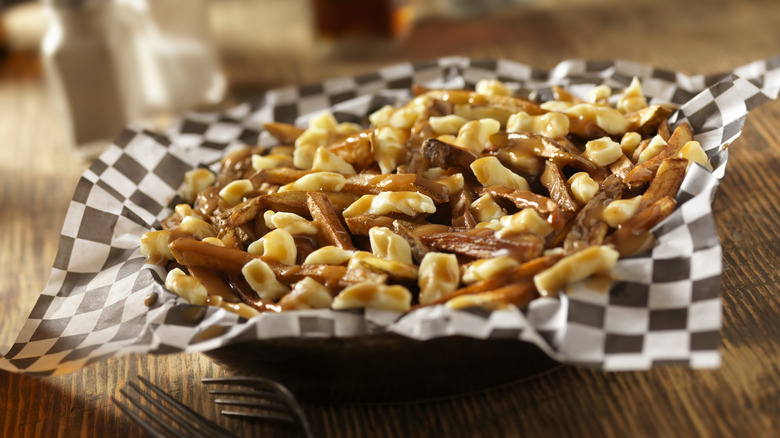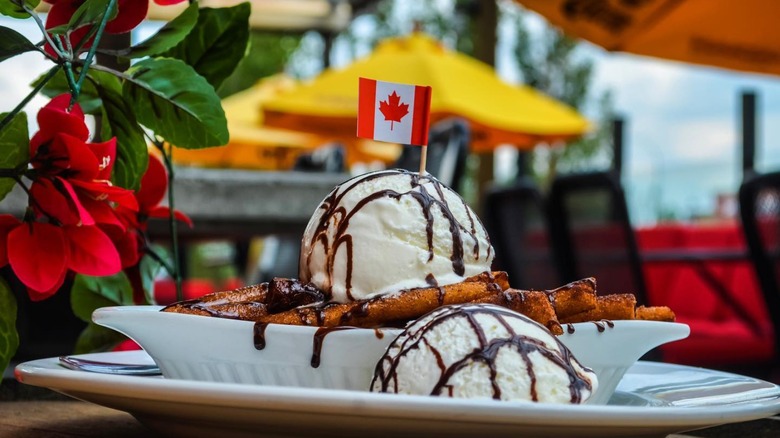Is Poutine Really Just A Fancy Name For Loaded Fries?
If I were to ask myself, "What is the difference between poutine and loaded fries?" I could then annoy the heck out of myself by answering with a similar question like "What is the difference between sirloin and steak?" This is one of those irritating logic problems so beloved by standardized test developers: If A = B, then must B = A? Not if A is a subset of B, which is the case with poutine and loaded fries. You can't just call any loaded fry dish "poutine" to sound fancy. Poutine evolved in Canada's Quebec province in the late '50s or early '60s and features cheese curds and gravy as toppings. Its Canadian history sets it apart from other types of loaded fries.
Cheese fries and chili fries are the ancestors of American loaded fries. Both of these dishes, like poutine, have murky origins, but they were also a mid-century phenomenon. Dairy Queen may have been among the first restaurants to catch on to the possibilities of loading up its fries with extra toppings, but over the years, numerous other fast-food chains have jumped on board the loaded fry train. Some of the best-known loaded fast food fries of the modern era include Taco Bell's notorious Nacho Fries, which have been re-introduced to the menu at least 10 times to date (at some point, they should just stay on the menu, right?), and In-N-Out's not-so-secret-menu animal-style fries that suck somewhat less than its standard ones.
Some poutine variations blur the lines
Over time, even the most traditional dishes may be tweaked by clever chefs. The venerable Le Roy Jucep, the Drummondville, Quebec, restaurant that claims to have invented poutine back in 1964, now offers over 30 varieties including Thai, Mexican, and pizza-style poutines as well as one made with wagyu beef that sounds absolument délicieux. Hipster poutine is also a thing — a Quebec City bistro called Le Chic Shack offers a poutine made with wild mushroom ragout and shallots and another with ale–braised beef, horseradish aioli, and pickled onions. Both feature locally sourced aged cheddar cheese curds (très chic, indeed).
As to what makes a poutine still a poutine and not cross over into loaded fry territory, well, that's kind of a blurry line. Many variant recipes will replace the brown gravy from the standard version with anything from spaghetti sauce to salsa, while even the cheese is subject to change. Some may swap out the curds for shreds or even (gasp!) grated cheese which seems to be particularly prevalent with vegan versions. Even sweet poutines exist, though what exactly differentiates The Canadian Brewhouse's ice cream and chocolate sauce-topped doughnut fries from any other sugar-loaded dessert fries is difficult to say. Perhaps the name of the restaurant chain, as well as its presence in five Canadian provinces, is all that's needed to establish the menu item's status as dessert poutine rather than mere loaded dessert fries.
The problem with American poutine
Every so often, someone on social media (or the regular media) will go on a rant about why poutine hasn't quite caught on the U.S., or worse, why American poutine is all messed up. Neither issue can really be addressed, however, without tackling the question of just what constitutes poutine. While not all Americans may be on board with the standard fries, gravy, and curds combo, we as a nation are fond of loaded fries (Admittedly, the Takeout staff denounced loaded fries back in the 20-teens, but it's a new decade and we're trying to be less judgy about the fact that the fries get soggy, which is also an issue with poutine). Poutine variations could very well become popular here, and a few American poutineries are offering these, including Rochester, New York's Petit Poutinerie and an Arizona food truck called The American Poutine Co.
The obstacle that potential American poutine makers may face is that when Canadian chefs change up their poutines, it's seen as perfectly acceptable, but any tweaking on the part of non-Canadians is seen as moving the dish out of the poutine category and back into the land of loaded fries. It seems the real answer to what makes poutine poutine may be that it must either contain the holy trinity of fries, gravy, and curds or be made in Canada by Canadians who declare it to be poutine, no matter what ingredients they use or omit.


